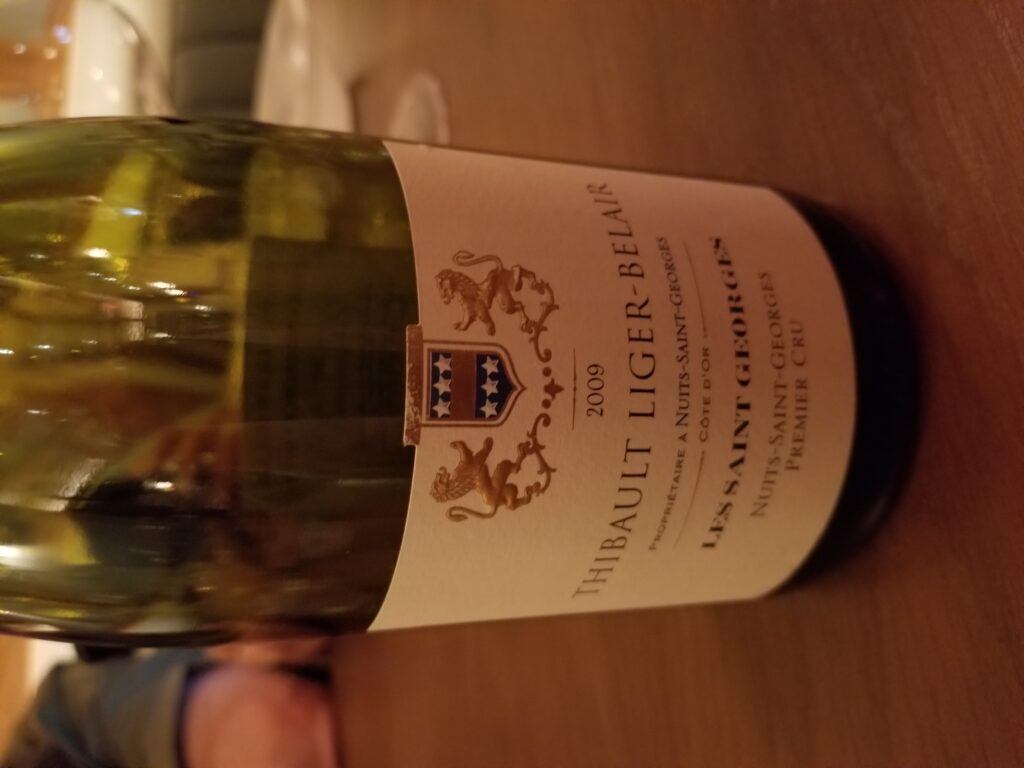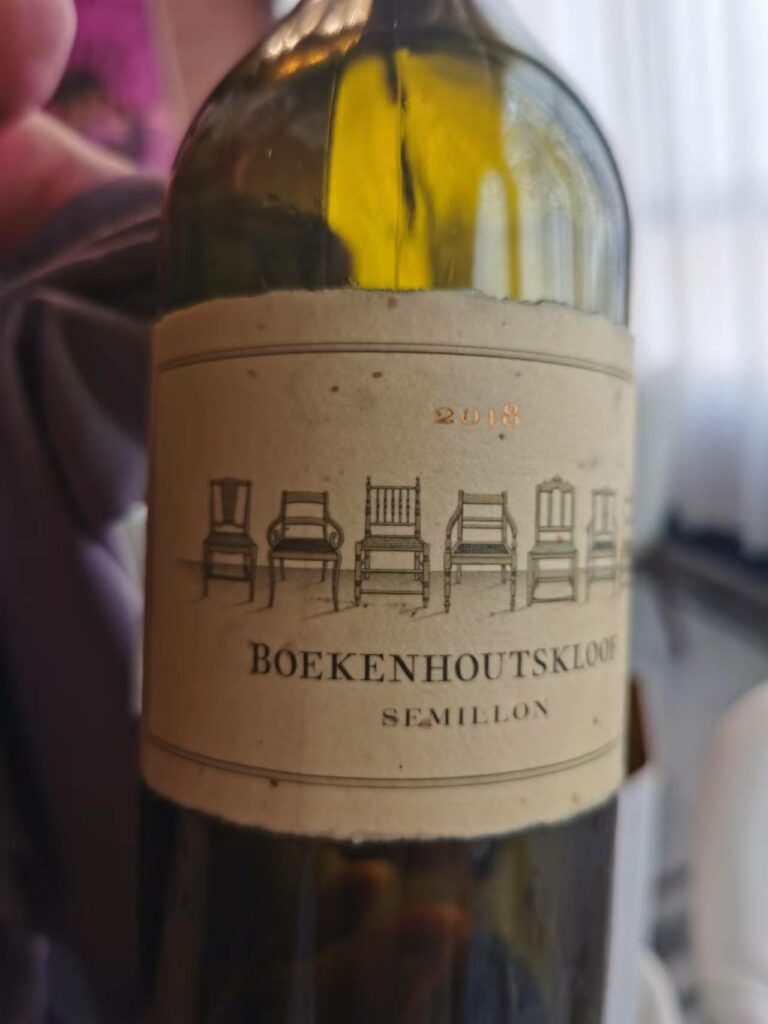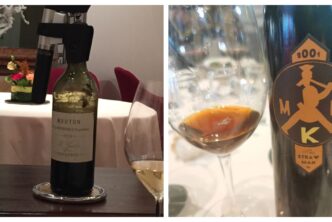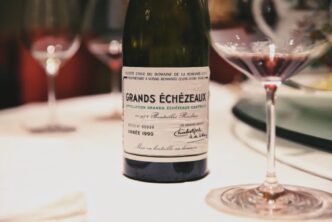Thibault Liger-Belair 2009 Nuits St. Georges Les Saint Georges 96

by Robert Millman
At a superb dinner in New York in one of the cities’ finest nouvelle-Korean restaurants we drank the last bottle from my cellar of an exceptional Nuits St. Georges Premier Cru: The 2009 Les Saint Georges from Thibault Liger Belair. The Les Saint Georges is a hallowed piece of vineyard land located towards the south of the village surrounded by two other first rate premier crus: Les Cailles to its immediate north and Vaucrains to the west. The terroir of Les Saint Georges is more complex and complete than any of the other thirty-six Premier Crus of the village. Anyone with experience of Les Saint Georges will likely concur with Clive Coates’ judgment that “you can easily be tempted into arguing its elevation to Grand Cru.” [The Wines of Burgundy (Page 155) ]. Indeed, the first classification of Burgundies, published by Dr. Jules Lavalle in 1855 included Les Saint Georges among the best wines: those he classified Tête de Cuvée or Grand Cru per the official 1936 classification. Two other Premier Crus have similar status: Meursault Perrières and Pommard Rugiens. Frankly there is a serious process to get these three vineyards upgraded to Grand Cru; but for reasons of affordability and availability, I hope that the wines from these three superb vineyards remain Premier Crus!
The original Liger-Belair estate is divided between cousins Louis Michel and Thibault Liger Belair. Under the heading Comte Liger Belair, Louis Michel is proprietor of a remarkable number of vineyards in Vosne-Romanée. These wines have been cultified and sell for astronomical prices at auction. Thibault’s holdings are diversified in Nuits St. Georges, Chambolle Musigny and lesser plots, but he owns vines in Clos Vougeot and Richebourg. But by his own admission, his favorite site is his holding in Les Saint Georges (there are at least two YouTube videos of Thibault discussing the magic terroir of Les Saint Georges). Located in the middle of the slope, the soil is a fascinating mixture of dark porous clay and tiny pieces of hard limestone called calcite. He has been running his vineyards biodynamically for a decade. The wines of Les Saint Georges stand out from other outstanding vineyards in Nuits St. Georges for their synthesis of density, richness and a delicacy not often found in wines of such intensity. The Thibault Liger-Belair 2009 Nuits St. Georges Les Saint Georges, now twelve years in the bottle, is inky-dark with a powerful, voluminous bouquet of very ripe dark fruits, iron and spice. The heat of the vintage is evident without interfering with the wine’s nobility and variety of flavors. The texture is both dense and uplifting, a Les Saint Georges specialty. The finish carries through the mid-palate expansion with a vitality that suggest the wine has years of life ahead. This is a noble, sensual red Burgundy which makes one grateful that wine can be so pleasurable and memorable at the same time. Drinking Window: 2022-2032.
Boekenhoutskloof 2018 Semillon Franschhoek Valley South Africa 94+

by Ian D’Agata
Now this is a truly gorgeous wine from the Franschhoek Valley in the Coastal Region of the Western Cape, one that showcases just how well Semillon performs in South Africa. You’ll find just about everything you know and expect from a high-quality Semillon wine in this bottle. Notes of beeswax, white peach, pear, tangerine, lemon curd and smoke? Check. Rarer nuances of tarragon, chamomile, fennel and lemongrass? Check. Rich texture? Check too. A lanolin mouthfeel? Check once more. Aging capacity with likely further development and noteworthy potential for real complexity? Check again. In short, this is a drop-dead gorgeous wine that is still an infant and ought to develop splendidly while making you wonder, at every sip, why there isn’t more Semillon planted all over the world and many more wines available. From a very great vintage, the Boekenhoutskloof 2018 Semillon Franschhoek Valley South Africa is an absolute beauty made from exceptionally old Semillon Blanc and Semillon Gris (the latter is a natural mutation of the former) plantings dating back to 1902, 1936 and 1942, enriched by a small touch of Moscato d’Alessandria (Muscat of Alexandria or Zibibbo). The 1902 and 1942 vines are non-irrigated bushvines planted on alluvial-loamy soil, while the 1936 vineyard is planted on decomposed granite and quartz.
Bright medium lemon-yellow color. Hints of flint and crushed stone complement the deep aromas of white peach, tangerine, beeswax, greengage, fennel and white flowers on the very complex, drop-dead gorgeous nose that also hints at peppery ginger and raisins. Rich and broad on entry, then explosive in the middle palate, mouthcoating but not at all heavy, and with lively but harmonious acidity lifting and extending the pure flavours of white orchard fruit, lemon curd, lemongrass and smoky grilled herbs. A wine of unerring concentration that is both tactile and voluminous, and boasting a savory finish that expands to coat the palate while really conveying an impression of very old vines. It’s slightly savory nuance, not to mention the aromas of raisins and peppery ginger, also conveys the presence of a little Moscato d’Alessandria (Muscat of Alexandria or Zibibbo) that the winery added to increase the wine’s aromatic palette. Knockout wine that will develop for years to come. Fermented in barriques and concrete eggs (the little addition of Moscato d’Alessandria is fermented on the skins and aged in concrete eggs), and aged fourteen months in 70% new oak barriques and 30% concrete eggs. Drinking window: 2024-2032.

 English
English

